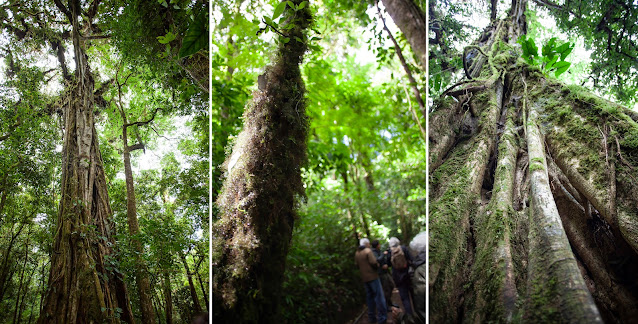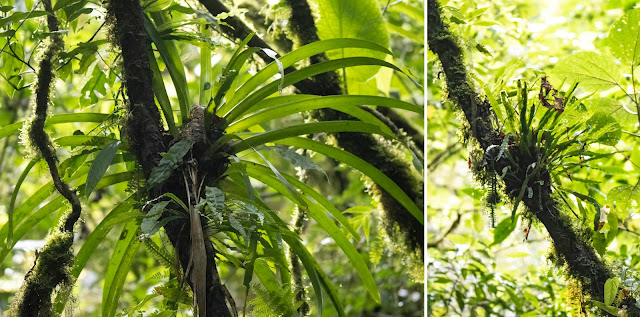A cloud forest, also called a water forest, elfin forest, primas forest or tropical montane cloud forest, is a generally tropical or subtropical moist forest characterized by a persistent, frequent or seasonal low-level cloud cover, usually at the canopy level.
Within cloud forests, much of the moisture available to plants arrives in the form of fog drip, where fog condenses on tree leaves and then drips onto the ground below.
Only 1 percent of the global woodland consists of cloud forests, but as recently as the 1970s, they comprised an about 11 percent of all tropical forests.
Monteverde Cloud Forest
Monteverde translates directly to “Green Mountain” and it certainly is green.
We spent two glorious days there, adding lots of birds to our tally. And, we had (a little) respite from oppressive heat.
 |
| Map: Wikipedia |
Located at 4,600 feet above sea level (remember, we drove there from sea level) in the Cordillera de Tilarán Mountains, Monteverde is a major destination for ecotourism.
 |
| Yellowish Flycatcher |
After the Spanish made landfall in 1502, the indigenous population fell from an estimated 400,000 to 80,000 within just 50 years. Unlike Nicaragua and Panama, however, Costa Rica did not have enough indigenous labor or mineral resources to attract a great deal of colonization.
In the first three decades of the 20th century, Creole populations arrived in small numbers to work in the gold mines or provide goods and services to miners. But, many local settlers came from the United States. Quakers from Fairhope, Alabama, who were against the draft before the Korean War, moved to Costa Rica and settled in Monteverde.
.jpeg) |
| Quakers had a big impact on the area; Photo: Costa Rica Travel Surf |
They liked Costa Rica’s non-violent, army-free constitution and friendly Costa Rican inhabitants.
 |
| Quakers in Monte Verde (its official spelling); Photo: John campbell |
And, they picked Monteverde because its cool climate was good for dairy farming. They stewarded and farmed a large tract of land, part of which they eventually set aside for conservation.
 |
| Looking over the soon-to-be reserve; Photo: John Campbell |
Today it is the Monteverde Cloud Forest Biological Reserve.
 |
| One of Costa Rica's most popular National Parks |
 |
| The plants look ancient, but many are relatively young |
 |
| Left, White-nosed Coati; Right, Red-tailed Squirrel |
 |
| Walking Stick |
During our time there, we birded in the vicinity and in the actual National Park.
It was the prettiest jungle we visited.
 |
| About half of Costa Rica's biodiversity is in this area, that's 2.5 percent of total world biodiversity |
Occasionally whimsical ...
 |
| CW: House Wren, Common Chlorospingus, Costa Rican Warbler, Plain Antvireo |
 |
| Not my photos; Left: Insight Guides; Right: BirdWatching Magazine |
... and it was a juvenile, so it didn't have the adult male's resplendent plumage ...
Our best encounter was actually a small, but very pretty, bird: the Slate-throated Redstart.
 |
| It is hard to get a shot this good in the jungle |
... posing occasionally and then moving to another perch ...
 |
| Posing in a rare sunny moment |
Very pretty ...
 |
| This one was a bit less orange than the other |
 |
| Three dark jungle birds: Black-faced Solitaire, Black Guan and Azure-hooded Jay |
Like other parts of Costa Rica, the most common tree is the Ficus, also known as the "strangler fig." Related to the Banyan, these lovely trees grow in dark forests where the competition for light is intense. So, they suck up nutrients from other trees, often causing them to eventually die.
Ficus trees are "hemiepiphytes." Their seeds, often bird-dispersed, germinate in crevices atop other trees and they spend the first part of their lives without rooting into the ground.
 |
| You can see our group walking among the trees in the middle photo |
 |
| Posing in front of one of the big, hollow ones |
The seedlings send their roots downward and envelop (AKA "strangle") the host tree while also growing upward to reach into the sunlight zone above the canopy. If the original support tree dies, the Ficus becomes a "columnar tree" with a hollow central core. We saw lots of hollow trees as we hiked.
Mosses, lichens and other epiphytes such as ferns cover the trunks and branches of the trees.
Begonias and other herbaceous plants grow in clearings, often to a very large size ...
... we headed to Monteverde's Hummingbird feeders, a special treat.
Hummingbirds
Monteverde National Park maintains a number of Hummingbird feeders near its cafe. It was crazy; filled with both people and Hummingbirds. See it here. Of course, the feeders were great. Especially because capturing Hummingbirds in the jungle is very tricky ...
 |
| A great variety of feeders |
But, getting the tiny birds on the nearby bushes was even better ...
 |
| Lesser Violetear hanging out away from the feeders |
... and the male, which does ..
 |
| I tried, but couldn't capture the purple |
This is a stunning bird, with its iridescent purple plumage. I believe all the ones I saw were males, which are brighter, but these aggressive birds were moving so fast, it was hard to tell ...
 |
| With its size and its color, you just can't miss it |
Another common bird at the feeder was the Green-crowned Brilliant, both males ...
 |
| Resting between feeding |
There was one (just one!) Magenta-throated Woodstar ...
 |
| This male zipped in and out quickly |
They must be somewhat rare in Monteverde, because Juan Diego was excited to see it.
There was also one Coppery-headed Emerald ...
I saw a couple of Rufous-tailed Hummingbirds, but didn't take many photos (I got a lot later) ...
 |
| You can see that rufous beneath the wings |
One of my favorites was the Lesser Violetear, which unlike many of its contemporaries, has no noticeable difference between male and female ...
 |
| A jewel-like creature |
 |
| See the ears? |
And, another really pretty species was the male Stripe-tailed Hummingbird, with its rufous wingbands ...
,%20Monteverde%20Cloud%20Forest,%20Costa%20Rica.jpg) |
| A striking Hummingbird |
... brilliant green body and flashes of deep blue in its gorget ...
 |
| Violet Sabrewing |
I wish our hotels had had feeders. We encountered Hummingbirds almost everywhere and, with feeders, probably could have seen even more.
Valle Escondido
 We veered from schedule again in Monteverde, skipping a couple of nearby reserves to, instead, go to Valle Escondido, a private reserve, because a guiding friend of Juan Diego's had discovered an Ornate Hawk-Eagle nest in the valley that you could view from above.
We veered from schedule again in Monteverde, skipping a couple of nearby reserves to, instead, go to Valle Escondido, a private reserve, because a guiding friend of Juan Diego's had discovered an Ornate Hawk-Eagle nest in the valley that you could view from above. |
| A gorgeous view |
This was exciting because we had briefly encountered an Ornate Hawk-Eagle in the Cloud Forest, but only for a split second as it cruised over our heads and disappeared into the canopy.
At Valle Escondido, it was just a quick walk to a beautiful overlook.
Then there it was: A beautiful adult tending a snow-white Chick ...
 |
| This was a treat |
It was far – too far to see with the naked eye. But, in my camera and through Juan Diego's scope, we got a nice view.
After we arrived, the adult flew off and was replaced by another adult that brought in some food ...
 |
| Taking off |
We thought it was going to get more interesting when a troop of Mantled Howler Monkeys (noisily) approached.
 |
| Noisy critters |
But, the adult Hawk-Eagle left, the Chick ate a little ...
 |
| Where did everybody go? |
... and looked around and the Howler Monkeys continued on their way ...
 |
| All alone |
 |
| Look at those legs |
 |
| A better picture; Photo: eBird |
Like many forest-dependent raptors, especially those in the tropical and subtropical regions, the Ornate Hawk-Eagle is seriously threatened by deforestation.
On our walk back to the van, we encountered a Black Guan, one of the few we saw on the trip ...
 |
| A Black Guan in the jungle |
Jaguarundi Lodge
My opening picture of a Lesson's Motmot gave away the name of the lodge we stayed in for the two nights we were in Monteverde. The Jaguarundi Lodge, named for a wild cat we did NOT see, feels like it is in the middle of nowhere, but actually is minutes from restaurants (including Mar y Tierra that I referenced in my first Costa Rica post), stores and tour companies.
The rooms are in stilted buildings that are reached by a suspended bridge (a bit tough to wheel luggage over) and feature a great deal of Costa Rica's ubiquitous red/brown wood. When you walk out your door, you feel like you are stepping into the jungle (because, actually, you are).
 |
| The balcony and my room |
In addition to the Motmot gracing the hotel sign, we saw a couple of Agoutis on the grounds. The Agouti is a larger cousin of the Guinea Pig with much longer legs and a fairly pungent smell ...
 |
| Another Costa Rican mammal |
...and Conceicao took a photo of what she thought was a Raccoon, but turned out to be a Mexican Porcupine ...
 |
| Mexican Porcupine; Photo: National Geographic |
 |
| Mar y Tierra coconut flan |
The hotel restaurant was closed because of COVID, except for breakfast (which was the same Costa Rican "typico" as everywhere else), so I can't really comment on it except to say it was fine.
It's shame because the setting tucked in the jungle was beautiful and probably would have made for a pleasant dinner.
But, I thought the hotel and grounds were lovely. And, our dinners (yeah, we went twice) at May y Tierra were the best on the trip.
Owling
We went out one evening in Monteverde in search of a Bare-shanked Screech-Owl, which we found. Unfortunately, it would not turn in my direction, so my photos just look like a strange lump on a log.
Trip date: March 9-27, 2022
















,%20Monteverde%20Cloud%20Forest,%20Costa%20Rica.jpg)






No comments:
Post a Comment